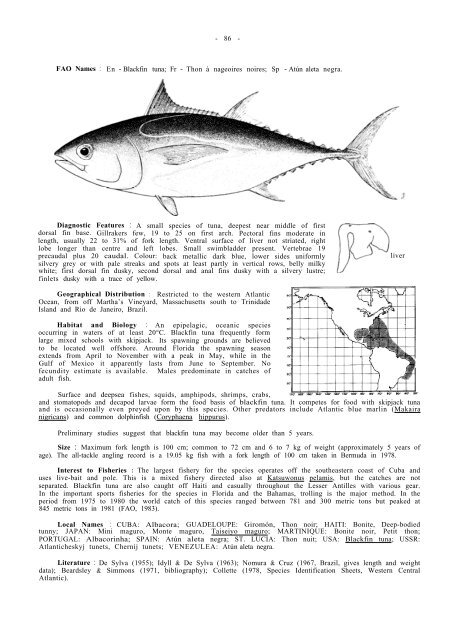FAO SPECIES CATALOGUE - si-pddr
FAO SPECIES CATALOGUE - si-pddr
FAO SPECIES CATALOGUE - si-pddr
Create successful ePaper yourself
Turn your PDF publications into a flip-book with our unique Google optimized e-Paper software.
- 86 -<br />
<strong>FAO</strong> Names : En - Blackfin tuna; Fr - Thon à nageoires noires; Sp - Atún aleta negra.<br />
Diagnostic Features : A small species of tuna, deepest near middle of first<br />
dorsal fin base. Gillrakers few, 19 to 25 on first arch. Pectoral fins moderate in<br />
length, usually 22 to 31% of fork length. Ventral surface of liver not striated, right<br />
lobe longer than centre and left lobes. Small swimbladder present. Vertebrae 19<br />
precaudal plus 20 caudal. Colour: back metallic dark blue, lower <strong>si</strong>des uniformly<br />
<strong>si</strong>lvery grey or with pale streaks and spots at least partly in vertical rows, belly milky<br />
white; first dorsal fin dusky, second dorsal and anal fins dusky with a <strong>si</strong>lvery lustre;<br />
finlets dusky with a trace of yellow.<br />
Geographical Distribution : Restricted to the western Atlantic<br />
Ocean, from off Martha’s Vineyard, Massachusetts south to Trinidade<br />
Island and Rio de Janeiro, Brazil.<br />
Habitat and Biology : An epipelagic, oceanic species<br />
occurring in waters of at least 20°C. Blackfin tuna frequently form<br />
large mixed schools with skipjack. Its spawning grounds are believed<br />
to be located well offshore. Around Florida the spawning season<br />
extends from April to November with a peak in May, while in the<br />
Gulf of Mexico it apparently lasts from June to September. No<br />
fecundity estimate is available. Males predominate in catches of<br />
adult fish.<br />
Surface and deepsea fishes, squids, amphipods, shrimps, crabs,<br />
and stomatopods and decapod larvae form the food ba<strong>si</strong>s of blackfin tuna. It competes for food with skipjack tuna<br />
and is occa<strong>si</strong>onally even preyed upon by this species. Other predators include Atlantic blue marlin (Makaira<br />
nigricans) and common dolphinfish (Coryphaena hippurus).<br />
Preliminary studies suggest that blackfin tuna may become older than 5 years.<br />
Size : Maximum fork length is 100 cm; common to 72 cm and 6 to 7 kg of weight (approximately 5 years of<br />
age). The all-tackle angling record is a 19.05 kg fish with a fork length of 100 cm taken in Bermuda in 1978.<br />
Interest to Fisheries : The largest fishery for the species operates off the southeastern coast of Cuba and<br />
uses live-bait and pole. This is a mixed fishery directed also at Katsuwonus pelamis, but the catches are not<br />
separated. Blackfin tuna are also caught off Haiti and casually throughout the Lesser Antilles with various gear.<br />
In the important sports fisheries for the species in Florida and the Bahamas, trolling is the major method. In the<br />
period from 1975 to 1980 the world catch of this species ranged between 781 and 300 metric tons but peaked at<br />
845 metric tons in 1981 (<strong>FAO</strong>, 1983).<br />
Local Names : CUBA: Albacora; GUADELOUPE: Giromón, Thon noir; HAITI: Bonite, Deep-bodied<br />
tunny; JAPAN: Mini maguro, Monte maguro, Taiseiyo maguro; MARTINIQUE: Bonite noir, Petit thon;<br />
PORTUGAL: Albacorinha; SPAIN: Atún aleta negra; ST. LUCIA: Thon nuit; USA: Blackfin tuna; USSR:<br />
Atlanticheskyj tunets, Chernij tunets; VENEZULEA: Atún aleta negra.<br />
Literature : De Sylva (1955); Idyll & De Sylva (1963); Nomura & Cruz (1967, Brazil, gives length and weight<br />
data); Beardsley & Simmons (1971, bibliography); Collette (1978, Species Identification Sheets, Western Central<br />
Atlantic).<br />
liver
















